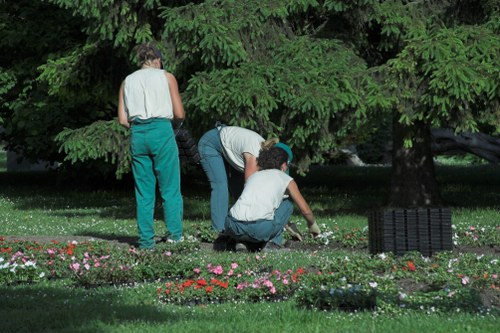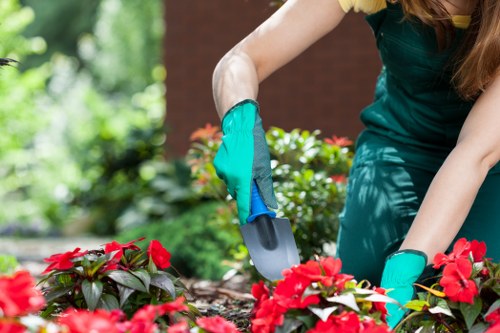Hedge Trimming in Belmont: Enhancing Your Garden’s Beauty
Why Hedge Trimming is Essential for Your Garden

Maintaining well-trimmed hedges is crucial for the overall health and aesthetics of your garden. In Belmont, where gardens are a cherished part of the community, regular hedge trimming ensures that your outdoor space remains attractive and well-kept.
Proper hedge trimming not only enhances the visual appeal but also promotes healthy growth. By removing dead or overgrown branches, you allow more sunlight and air to reach the plants, reducing the risk of diseases and pests.
Moreover, well-maintained hedges can serve various functional purposes, such as providing privacy, acting as windbreaks, and delineating property boundaries. Whether you have a small garden or a large estate, regular hedge trimming is a fundamental aspect of garden maintenance.
Techniques for Effective Hedge Trimming

Achieving beautifully trimmed hedges requires the right techniques and tools. Here are some methods to ensure your hedges in Belmont look their best:
- Planning: Before starting, plan the shape and size of your hedge. This will guide your trimming process and help maintain a consistent appearance.
- Tools: Use sharp and appropriate tools such as hedge shears, electric trimmers, and loppers. Clean tools ensure precise cuts and reduce the risk of plant damage.
- Trimming: Begin by removing any dead or damaged branches. Then, shape the hedge by trimming the sides and top, maintaining an even and uniform outline.
Consistent trimming encourages dense growth and prevents the hedge from becoming too unruly. It's advisable to trim hedges at least twice a year—once in late spring and again in late summer.
Choosing the Right Tools for Hedge Trimming

Having the right tools is essential for efficient and effective hedge trimming. Here are some tools commonly used in Belmont for hedge maintenance:
- Manual Hedge Shears: Ideal for small to medium-sized hedges, offering precision and control.
- Electric Hedge Trimmers: Suitable for larger hedges, providing speed and ease of use with less physical effort.
- Pruning Saws: Useful for cutting thicker branches that shears and trimmers can't handle.
- Loppers: Perfect for mid-sized branches, offering the strength needed for clean cuts.
Investing in high-quality tools can significantly improve the efficiency of your hedge trimming tasks and contribute to the long-term health of your plants.
Professional Hedge Trimming Services in Belmont

While DIY hedge trimming is possible, hiring professional services in Belmont can offer several advantages:
- Expertise: Professionals have the knowledge and experience to trim hedges properly, ensuring healthy growth and an aesthetically pleasing appearance.
- Time-Saving: Outsourcing hedge trimming saves you valuable time, allowing you to focus on other aspects of garden maintenance or personal activities.
- Safety: Trimming large hedges or high branches can be hazardous. Professionals are equipped with the necessary tools and safety gear to perform the task safely.
Consider contacting a reputable hedge trimming service in Belmont to maintain the beauty and health of your garden effortlessly.
Seasonal Hedge Trimming Tips

Different seasons require specific hedge trimming practices to ensure optimal growth and health:
- Spring: Early spring is the ideal time for light trimming and shaping, encouraging new growth.
- Summer: Mid-summer trimming helps maintain the desired shape and prevents hedges from becoming too dense.
- Autumn: Late autumn trimming removes any damaged branches and prepares hedges for the winter months.
- Winter: Minimal trimming is required; focus on protecting hedges from frost and harsh weather conditions.
Adapting your hedge trimming routine to the seasons can significantly impact the vitality and appearance of your hedges throughout the year.
Choosing the Right Plants for Your Hedges
Selecting the appropriate plants for your hedges is fundamental to achieving the desired look and functionality. In Belmont, some popular hedge plants include:
- Boxwood: Known for its dense foliage and versatility in shaping.
- Privet: Fast-growing and excellent for creating privacy screens.
- Laurel: Offers glossy leaves and can tolerate heavy pruning.
- Holly: Provides beautiful berries and a striking appearance during winter.
Choosing plants that are well-suited to Belmont’s climate and soil conditions ensures that your hedges thrive with minimal maintenance.
Common Mistakes to Avoid in Hedge Trimming
To maintain healthy and attractive hedges, it's important to avoid common trimming mistakes:
- Over-Trimming: Removing too much foliage can stress the plant and hinder its growth.
- Incorrect Timing: Trimming at the wrong time of year can disrupt the plant’s natural growth cycle.
- Poor Tool Maintenance: Using dull or dirty tools can cause uneven cuts and increase the risk of disease.
- Ignoring Plant Health: Failing to address underlying health issues before trimming can exacerbate problems.
Being mindful of these pitfalls ensures that your hedge trimming efforts contribute positively to your garden’s health and beauty.
Environmental Benefits of Hedge Trimming
Regular hedge trimming not only benefits your garden but also has positive environmental impacts:
- Enhanced Air Circulation: Trimming allows better air flow around the plants, reducing the likelihood of fungal diseases.
- Increased Sunlight Exposure: Removing excess foliage ensures that all parts of the hedge receive adequate sunlight, promoting uniform growth.
- Wildlife Support: Well-maintained hedges can provide habitats for various birds and beneficial insects.
- Carbon Sequestration: Healthy hedges contribute to carbon dioxide absorption, aiding in climate regulation.
Maintaining your hedges through proper trimming practices supports a healthier and more sustainable environment.
Cost-Effective Hedge Trimming Solutions
Managing the cost of hedge trimming can be achievable with thoughtful planning and resource management:
- DIY vs. Professional Services: Weigh the costs and benefits of doing it yourself versus hiring experts. While DIY may save money upfront, professional services ensure quality and longevity.
- Tool Investment: Purchasing quality trimming tools can reduce the frequency of replacements and improve efficiency.
- Regular Maintenance: Routine trimming prevents the need for extensive and costly overhauls later.
- Seasonal Packages: Some professional services offer seasonal packages that provide discounted rates for multiple trims throughout the year.
By adopting cost-effective strategies, you can maintain your hedges beautifully without straining your budget.
Hedge Trimming Safety Tips
Ensuring safety during hedge trimming is paramount to prevent accidents and injuries:
- Wear Protective Gear: Use gloves, safety glasses, and appropriate clothing to protect against debris and sharp tools.
- Use the Right Tools: Ensure that your trimming tools are in good condition and suitable for the task.
- Work in Good Conditions: Avoid trimming in poor weather or low light to maintain visibility and control.
- Maintain Balance: When using ladders or standing on elevated surfaces, ensure proper balance to prevent falls.
Adhering to these safety tips ensures that your hedge trimming activities are both effective and accident-free.
Benefits of Regular Hedge Trimming
Consistent hedge trimming offers numerous advantages that extend beyond mere appearance:
- Healthier Plants: Regular trimming removes diseased or damaged branches, promoting overall plant health.
- Better Growth: Encourages dense and robust growth by directing energy to healthy parts of the plant.
- Enhanced Curb Appeal: Well-trimmed hedges enhance the visual appeal of your property, potentially increasing its market value.
- Weed Control: Trimming reduces the space available for weeds to grow, simplifying garden maintenance.
These benefits make hedge trimming a vital practice for maintaining a vibrant and healthy garden in Belmont.
Choosing the Right Time for Hedge Trimming
Timing is crucial when it comes to hedge trimming. Here are some guidelines to help you decide the best times to trim your hedges in Belmont:
- Early Spring: Before new growth begins, trimming helps shape the hedge and remove any winter damage.
- Late Spring to Early Summer: A mid-season trim encourages bushier growth and maintains the desired shape.
- Late Summer to Early Autumn: Prepares the hedge for the approaching winter, ensuring it remains healthy and resilient.
By adhering to these timing suggestions, you can optimize the health and appearance of your hedges throughout the year.
Environmental Considerations in Hedge Trimming
Being mindful of environmental factors can enhance the effectiveness of your hedge trimming practices:
- Sustainable Practices: Use eco-friendly tools and avoid chemical treatments to maintain a healthy garden ecosystem.
- Water Conservation: Trim hedges to promote efficient water usage, ensuring that plants do not require excessive watering.
- Wildlife Preservation: Maintain some natural growth to provide habitats for beneficial insects and birds.
- Composting Clippings: Recycle trimmed branches and leaves through composting, reducing waste and enriching your soil.
Incorporating these environmental considerations ensures that your hedge trimming contributes positively to the broader ecosystem.
Innovative Hedge Trimming Designs
Exploring creative hedge trimming designs can add a unique touch to your garden:
- Topiary Art: Shaping hedges into artistic forms like animals, geometric shapes, or abstract patterns.
- Layered Hedges: Creating depth by varying the heights and shapes of different hedge plants.
- Symmetrical Designs: Achieving a balanced and harmonious look with evenly trimmed hedges.
- Asymmetrical Styles: Adding an organic and natural feel with uneven or irregular shapes.
These innovative designs can transform your hedges from simple barriers into stunning garden features, enhancing the overall appeal of your outdoor space.
Maintaining Hedge Trimming Tools
Proper maintenance of your hedge trimming tools ensures longevity and effective performance:
- Regular Cleaning: Remove sap, dirt, and debris from your tools after each use to prevent rust and deterioration.
- Sharpening Blades: Keep blades sharp for clean cuts, reducing the risk of damaging your hedges.
- Lubrication: Apply oil to moving parts to ensure smooth operation and prevent rust.
- Proper Storage: Store tools in a dry, protected area to extend their lifespan.
By maintaining your hedge trimming tools diligently, you can enhance their efficiency and ensure that your hedge trimming tasks are performed seamlessly.
Seasonal Challenges in Hedge Trimming
Different seasons present unique challenges for hedge trimming. Being prepared can help you address these effectively:
- Winter: Cold temperatures can make hedges brittle. Trim with care to avoid breaking branches.
- Summer: High heat can stress plants. Trim during cooler parts of the day and ensure adequate watering.
- Spring: Rapid growth may require more frequent trimming to maintain shape.
- Autumn: Fallen leaves can obscure trimmed shapes. Clear debris regularly to keep hedges looking neat.
Understanding and anticipating these seasonal challenges allows you to maintain healthy and attractive hedges year-round.
Enhancing Curb Appeal with Hedge Trimming
Your hedges play a significant role in the curb appeal of your property. Here’s how proper trimming can make a difference:
- First Impressions: Neatly trimmed hedges create a welcoming and organized appearance, enhancing the overall look of your home.
- Property Value: Well-maintained gardens, including trimmed hedges, can increase your property’s market value.
- Personal Satisfaction: A beautiful garden provides personal enjoyment and a sense of pride in your property.
- Neighborhood Standards: Maintaining your hedges ensures that your property aligns with neighborhood aesthetics and standards.
Investing time and effort into hedge trimming can yield significant benefits in terms of both personal satisfaction and property value.
Hedge Trimming and Pest Control
Regular hedge trimming can play a role in pest management:
- Removing Infested Branches: Trimming eliminates parts of the hedge that may be infested with pests, preventing their spread.
- Improving Airflow: Better airflow reduces the likelihood of mold and fungal growth, which can attract pests.
- Encouraging Beneficial Insects: A well-maintained hedge attracts beneficial insects that prey on harmful pests.
- Preventing Overgrowth: Overgrown hedges can harbor pests, so regular trimming keeps their population in check.
Incorporating pest control strategies into your hedge trimming routine ensures a healthier and more resilient garden.
Choosing Sustainable Hedge Trimming Practices
Embracing sustainability in hedge trimming helps create an eco-friendly garden:
- Organic Trimming Solutions: Use natural fertilizers and pest control methods to maintain hedge health without harmful chemicals.
- Energy-Efficient Tools: Opt for electric or manual trimming tools over gas-powered ones to reduce your carbon footprint.
- Recycling Clippings: Compost trimmed branches and leaves to enrich your soil and reduce waste.
- Water Conservation: Implement efficient watering systems to support healthy hedges with minimal water usage.
Adopting these sustainable practices contributes to a greener environment and promotes the long-term health of your garden.
Final Thoughts on Hedge Trimming in Belmont
Hedge trimming is a vital component of garden maintenance that offers numerous benefits, from enhancing aesthetics to promoting plant health. Whether you choose to undertake the task yourself or hire professional services in Belmont, consistent and proper trimming ensures that your hedges remain beautiful and functional year-round.
Embrace the art of hedge trimming to transform your garden into a serene and inviting space. Contact us today to learn more about our expert hedge trimming services and take the first step towards a more beautiful garden.